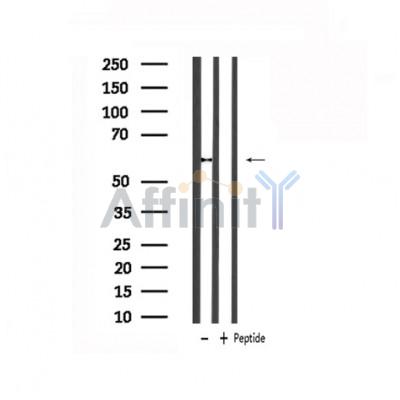Angiopoietin 2 Antibody - #DF6137
| Product: | Angiopoietin 2 Antibody |
| Catalog: | DF6137 |
| Description: | Rabbit polyclonal antibody to Angiopoietin 2 |
| Application: | WB IHC IF/ICC |
| Cited expt.: | IF/ICC |
| Reactivity: | Human, Mouse, Rat |
| Mol.Wt.: | 55~70kD; 57kD(Calculated). |
| Uniprot: | O15123 |
| RRID: | AB_2838104 |
Related Downloads
Protocols
Product Info
*The optimal dilutions should be determined by the end user. For optimal experimental results, antibody reuse is not recommended.
*Tips:
WB: For western blot detection of denatured protein samples. IHC: For immunohistochemical detection of paraffin sections (IHC-p) or frozen sections (IHC-f) of tissue samples. IF/ICC: For immunofluorescence detection of cell samples. ELISA(peptide): For ELISA detection of antigenic peptide.
Cite Format: Affinity Biosciences Cat# DF6137, RRID:AB_2838104.
Fold/Unfold
AGPT 2; Agpt2; ANG 2; ANG-2; ANG2; Angiopoietin 2a; Angiopoietin 2B; Angiopoietin-2; Angiopoietin2; ANGP2_HUMAN; ANGPT 2; Angpt2; Tie2 ligand;
Immunogens
A synthesized peptide derived from human Angiopoietin 2, corresponding to a region within N-terminal amino acids.
- O15123 ANGP2_HUMAN:
- Protein BLAST With
- NCBI/
- ExPASy/
- Uniprot
MWQIVFFTLSCDLVLAAAYNNFRKSMDSIGKKQYQVQHGSCSYTFLLPEMDNCRSSSSPYVSNAVQRDAPLEYDDSVQRLQVLENIMENNTQWLMKLENYIQDNMKKEMVEIQQNAVQNQTAVMIEIGTNLLNQTAEQTRKLTDVEAQVLNQTTRLELQLLEHSLSTNKLEKQILDQTSEINKLQDKNSFLEKKVLAMEDKHIIQLQSIKEEKDQLQVLVSKQNSIIEELEKKIVTATVNNSVLQKQQHDLMETVNNLLTMMSTSNSAKDPTVAKEEQISFRDCAEVFKSGHTTNGIYTLTFPNSTEEIKAYCDMEAGGGGWTIIQRREDGSVDFQRTWKEYKVGFGNPSGEYWLGNEFVSQLTNQQRYVLKIHLKDWEGNEAYSLYEHFYLSSEELNYRIHLKGLTGTAGKISSISQPGNDFSTKDGDNDKCICKCSQMLTGGWWFDACGPSNLNGMYYPQRQNTNKFNGIKWYYWKGSGYSLKATTMMIRPADF
Research Backgrounds
Binds to TEK/TIE2, competing for the ANGPT1 binding site, and modulating ANGPT1 signaling. Can induce tyrosine phosphorylation of TEK/TIE2 in the absence of ANGPT1. In the absence of angiogenic inducers, such as VEGF, ANGPT2-mediated loosening of cell-matrix contacts may induce endothelial cell apoptosis with consequent vascular regression. In concert with VEGF, it may facilitate endothelial cell migration and proliferation, thus serving as a permissive angiogenic signal.
Secreted.
The Fibrinogen C-terminal domain mediates interaction with the TEK/TIE2 receptor.
Research Fields
· Environmental Information Processing > Signal transduction > MAPK signaling pathway. (View pathway)
· Environmental Information Processing > Signal transduction > Ras signaling pathway. (View pathway)
· Environmental Information Processing > Signal transduction > Rap1 signaling pathway. (View pathway)
· Environmental Information Processing > Signal transduction > HIF-1 signaling pathway. (View pathway)
· Environmental Information Processing > Signal transduction > PI3K-Akt signaling pathway. (View pathway)
References
Application: IF/ICC Species: human Sample: HUVECs
Restrictive clause
Affinity Biosciences tests all products strictly. Citations are provided as a resource for additional applications that have not been validated by Affinity Biosciences. Please choose the appropriate format for each application and consult Materials and Methods sections for additional details about the use of any product in these publications.
For Research Use Only.
Not for use in diagnostic or therapeutic procedures. Not for resale. Not for distribution without written consent. Affinity Biosciences will not be held responsible for patent infringement or other violations that may occur with the use of our products. Affinity Biosciences, Affinity Biosciences Logo and all other trademarks are the property of Affinity Biosciences LTD.






